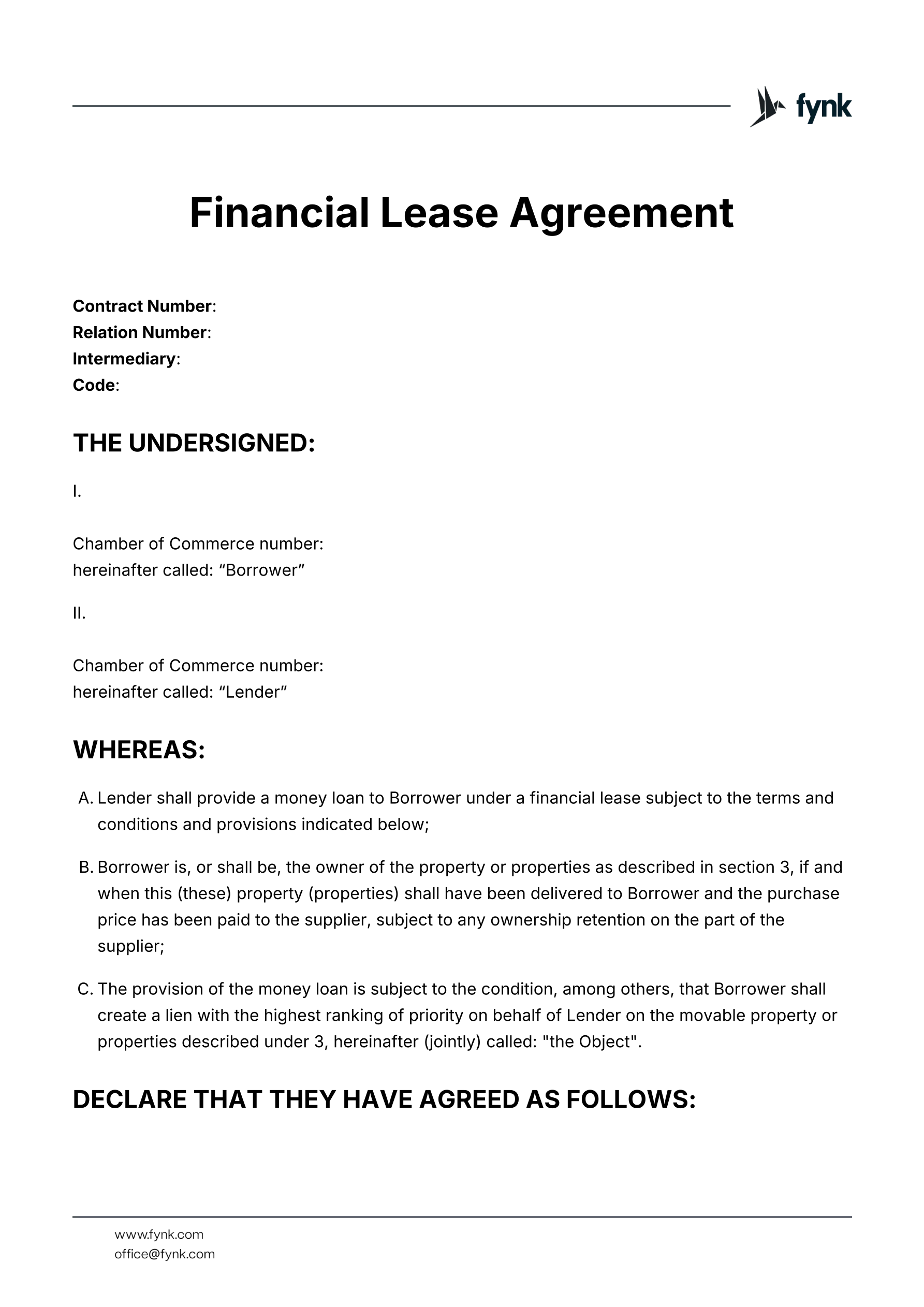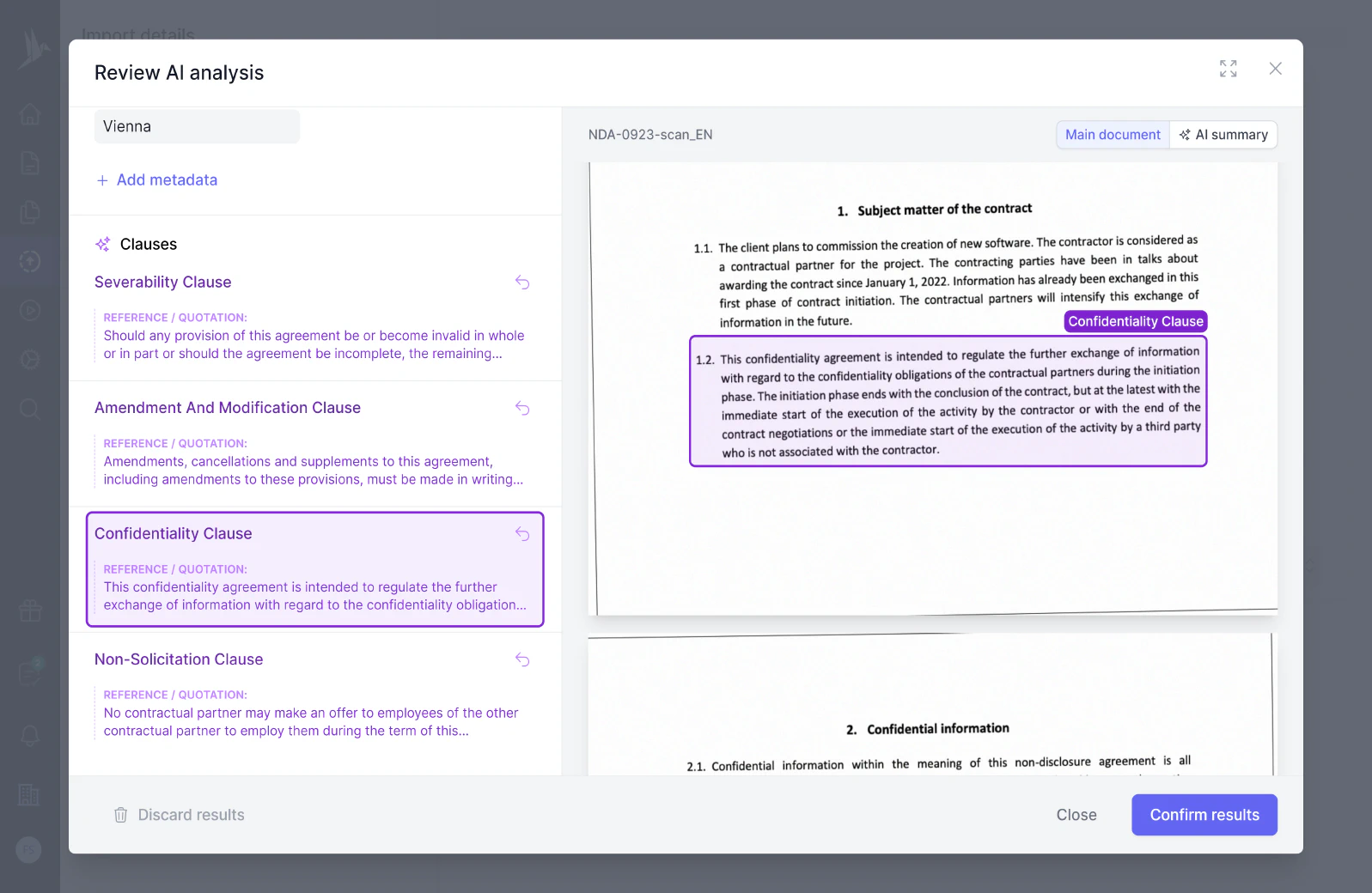
Financial Lease Agreement Template
A detailed financial lease agreement template that sets out loan terms, repayment schedules, security interests, and obligations of both lender and client.
"Termination with cause" refers to a contract provision that allows one party to end the agreement if the other party engages in specific misconduct or breaches the contract's terms. This clause typically outlines what constitutes "cause," such as failure to meet obligations, illegal activity, or unethical behavior.
2. The definition of “Voluntary Termination with Cause” is replaced in its entirety to read as follows: “Voluntary Termination with Cause” occurs upon a Recipient’s separation from service of his or her own volition and one or more of the following conditions occurs without the Recipient’s consent on or after a Change of Control: (a)There is a material diminution in the Recipient’s base compensation, compared to his or her rate of base compensation on the date of the Change of Control. (b) There is a material diminution in the Recipient’s authority, duties, or responsibilities.
Notwithstanding the foregoing provisions of this definition, if the Company remedies the adverse condition within 30 days of being notified of the adverse condition, no Voluntary Termination with Cause shall occur.
8. TERMINATION. (a) Grounds. This Agreement shall terminate in the event of the Executive’s death. In the case of the Executive’s Disability, the Company may elect to terminate the Executive’s employment as a result of such Disability. The Company also may terminate the Executive’s employment pursuant to a Termination With Cause or a Termination Without Cause. Finally, the Executive may terminate the Executive’s employment with the Company pursuant to either a Voluntary Termination or a Voluntary Termination for Good Reason. For purposes of this Agreement, the terms Disability, Voluntary Termination, Voluntary Termination for Good Reason, Termination With Cause and Termination Without Cause are defined in Section 11 of this Agreement.
9. COMPENSATION UPON TERMINATION WITH CAUSE, VOLUNTARY TERMINATION, DEATH OR DISABILITY. This Section 9 applies in the event that the Executive’s employment ends upon a Termination With Cause, a Voluntary Termination, death or Disability or any reason other than a Termination Without Cause or a Voluntary Termination With Good Reason. In any of those events, the Executive (or the Executive’s estate in the event of the Executive’s death) shall be entitled to receive the Standard Termination Benefits. The Standard Termination Benefits are the benefits or amounts described in the following subsections (a) and (b): (a)The Executive shall be entitled to receive any compensation (including Base Salary and Annual Bonus (and LTIP Units in lieu of Annual Bonus under Section 6(c)(iii) and accrued but unused vacation) that is earned prior to the Date of Termination but that remains unpaid as of the Date of Termination, which shall be paid in a single cash payment within fifteen (15) days of the Date of Termination. (b) The Executive shall be entitled to receive any benefits due the Executive under the terms of any employee benefit plan maintained by the Company and under the terms of any option, restricted stock, restricted stock units or other equity award; which benefits shall be paid in accordance with the terms of the applicable plan and any award agreement between the Executive and the Company.
(f) “Termination With Cause” means the termination of the Executive’s employment by act of the Board on account of (i) the Executive’s failure to perform a material duty as directed by the Board other than by reason of the Executive’s mental or physical illness or injury, (ii) the Executive’s material breach of an obligation set forth in this Agreement or a breach of a material and written Company policy other than by reason of the Executive’s mental or physical illness or injury, (iii) the Executive’s breach of Executive’s fiduciary duties to the Company, (iv) the Executive’s conduct that is demonstrably and materially injurious to the Company, monetarily or otherwise, or (v) the Executive’s conviction of, or plea of guilty or nolo contendre to, a felony or crime involving moral turpitude or fraud or dishonesty involving assets of the Company. The Executive’s termination shall not be deemed a “Termination With Cause” unless the Board has given the Executive written notice of the grounds for such termination as required by Section 8(c) and the Executive has failed to cure such grounds to the reasonable satisfaction of the Board during the thirty (30) day period following the Executive’s receipt of the notice.
(g) “Termination Without Cause” means the termination of the Executive’s employment by the Company that does not constitute a Termination With Cause. For the avoidance of doubt, termination of the Executive’s employment on account of death, Disability or Voluntary Termination is not a Termination Without Cause.
(d) Involuntary termination with Cause defined. For purposes of this Agreement involuntary termination of the Executive’s employment shall be considered involuntary termination with Cause if the Executive shall have committed any of the following acts – 1) an act of fraud, embezzlement, or theft while employed by Middlefield or a subsidiary, or conviction of the Executive for or plea of no contest to a felony or conviction of or plea of no contest to a misdemeanor involving moral turpitude, or the actual incarceration of the Executive for 45 consecutive days or more, or 2) gross negligence, insubordination, disloyalty, or dishonesty in the performance of the Executive’s duties as an officer of Middlefield or a subsidiary; willful or reckless failure by the Executive to adhere to Middlefield’s or subsidiary’s written policies; intentional wrongful damage by the Executive to the business or property of Middlefield or subsidiary, including without limitation its reputation, which in Middlefield’s sole judgment causes material harm to Middlefield or subsidiary; breach by the Executive of fiduciary duties to Middlefield and its stockholders, whether in the Executive’s capacity as an officer or as a director of Middlefield or subsidiary, or 3) removal of the Executive from office or permanent prohibition of the Executive from participating in the affairs of Middlefield’s subsidiary bank or banks by an order issued under section 8(e)(4) or (g)(1) of the Federal Deposit Insurance Act, 12 U.S.C. 1818(e)(4) or (g)(1), or 4) intentional wrongful disclosure of secret processes or confidential information of Middlefield or affiliates, which in Middlefield’s sole judgment causes material harm to Middlefield or affiliates, or 5) any actions that have caused the Executive to be terminated with cause under any employment agreement existing on the date hereof or hereafter entered into between the Executive and Middlefield or a subsidiary, or 6) the occurrence of any event that results in the Executive being excluded from coverage, or having coverage limited for the Executive as compared to other executives of Middlefield or affiliates, under a blanket bond or other fidelity or insurance policy covering directors, officers, or employees, or 7) intentional wrongful engagement in any competitive activity. For purposes of this Agreement competitive activity means the Executive’s participation, without the consent of Middlefield’s board of directors, in the management of any business enterprise if (x) the enterprise engages in substantial and direct competition with Middlefield, (y) the enterprise’s revenues derived from any product or service competitive with any product or service of Middlefield or a subsidiary amounted to 10% or more of the enterprise’s revenues for its most recently completed fiscal year, and (z) Middlefield’s revenues from the product or service amounted to 10% of Middlefield’s revenues for its most recently completed fiscal year. A competitive activity does not include mere ownership of securities in an enterprise and the exercise of rights appurtenant thereto, provided the Executive’s share ownership does not represent practical or legal control of the enterprise. For this purpose, ownership of less than 5% of the enterprise’s outstanding voting securities shall conclusively be presumed to be insufficient for practical or legal control, and ownership of more than 50% shall conclusively be presumed to constitute practical and legal control.
(c) Termination With Cause by the Company or Resignation Without Good Reason by Employee. (i) The Company may terminate Employee’s employment (a “Termination With Cause”) upon written notice following its determination that Employee has committed any of the following acts: (A) conviction of or guilty/no contest plea to a felony or a crime involving moral turpitude, the nature and circumstances of which are determined in the Company’s discretion to disqualify Employee from continued employment with Company; (B) fraud; (C) embezzlement or other misappropriation of funds; (D) material misrepresentation with respect to the Company; (E) substantial and/or repeated failure to perform duties; (F) gross negligence or willful misconduct in the performance of duties; (G) commission of any act or material involvement in any situation, or occurrence, whether before or during the Term, which brings the Company into widespread public disrepute, contempt, scandal or ridicule, or which justifiably shocks, insults or offends a significant portion of the community, or Employee’s or the Company’s being subject to publicity for any such act or involvement; (H) material violation of the Employee Handbook, the Code of Conduct or any other written Company policy, including, without limitation, a material violation of the Company’s anti-harassment and anti-discrimination policies; or (I) material breach of this Agreement (which, as to the last two items, if capable of being cured (as reasonably determined by the Company), shall remain uncured following ten (10) business days after written notice thereof) .
(a) Termination with Cause. Unless otherwise provided under the termination with “cause” provisions of an Individual Agreement, to invoke a termination with Cause, NBHC must provide written notice to Participant of the existence of such grounds within 30 days following NBHC’s knowledge of the existence of such grounds, specifying in reasonable detail the grounds constituting Cause, and, with respect to the grounds enumerated in clauses (A), (C), (D), and (E) in the definition of Cause in the Plan, Participant shall have 30 days following receipt of such written notice during which he or she may remedy the ground if such ground is reasonably subject to cure as determined by NBHC. (b) “Good Reason” shall have the meaning given to such term in an Individual Agreement, or if there is no such Individual Agreement or if it does not define Good Reason, then, Good Reason shall mean the occurrence of the following, in the absence of Participant’s written consent: (i) a material diminution in Participant’s annual base salary from that in effect immediately prior to a Change in Control; or (ii) the assignment to Participant of any duties materially inconsistent with Participant’s positions (including status, offices, titles, and reporting requirements), authority, duties, or responsibilities, or any other action by NBHC that results in a material diminution in such positions, authority, duties, or responsibilities, in each case, from those in effect immediately prior to a Change in Control; provided that, in each case, (A) Participant provides written notice to NBHC of the existence of one or more of the conditions described in clauses (i) through (ii) within 30 days following Participant’s knowledge of the initial existence of such condition or conditions, specifying in reasonable detail the conditions constituting Good Reason; (B) NBHC and its Affiliates fail to cure such event or condition within 30 days following the receipt of such notice; and (C) Participant incurs a Termination of Employment within 30 days following the expiration of such cure period.
5.3.3 “Termination with Cause” shall mean (i) the Executive’s willful, intentional and continued substantial misconduct in the reasonable judgment of the Company; (ii) other than due to a Disability, the Executive’s repeated, intentional gross negligence of duties or intentional gross failure to act which can reasonably be expected to affect materially and adversely the business or affairs of the Company or any subsidiary or affiliate thereof in the reasonable judgment of the Company; (iii) the Executive’s gross material breach of any of the obligations contained herein; or (iv) the commission by the Executive of any intentional material fraudulent act with respect to the business and affairs of the Company or any subsidiary or affiliate thereof, in the reasonable judgment of the Company. Executive shall be given written notice of the Company’s intent to terminate his employment for cause and shall have 15 days in which to cure such claimed defect.
In the event of Termination with Cause, EXECUTIVE shall be paid EXECUTIVE's salary through the effective date of termination on the date of termination. After the effective date of Termination with Cause, EXECUTIVE shall not be entitled to accrue or vest in any further salary, severance pay, stock options, restricted stock units, performance stock units, benefits, fringe benefits or entitlements; provided that EXECUTIVE shall retain the right to exercise any stock options which are vested as of the effective date of termination for a period of ninety (90) days.
6.1 Termination with Cause. Despite any contrary provision of this Agreement, the Bank shall not pay any benefit under this Agreement and this Agreement shall terminate if Separation from Service is a Termination with Cause.
Termination with cause refers to the dismissal of an employee or the discontinuation of a contract due to specific reasons that are typically predefined and justified—common grounds include gross misconduct, chronic absenteeism, dishonesty, and violation of company policies, all of which may necessitate knowing exactly how to terminate a contract.
Termination with cause should be employed when an employee or contracting party has violated legal or company policies in a manner that disrupts the organization’s operations or breaches the contractual agreement. It’s essential to ensure that:
Employers should seek legal advice when uncertain about the grounds for termination with cause to minimize the risk of disputes or wrongful termination claims.
When drafting a termination with cause clause, it’s important to clearly outline the conditions and behaviors that would justify termination. A well-structured clause includes:
Example: “The Company may terminate Employee’s employment with cause if Employee engages in conduct constituting theft, fraud, or a material breach of any Company policy. Prior to termination, Employee will be provided with written notice of the alleged behavior and an opportunity to respond.”
Termination with cause clauses are common in various types of contracts where parties aim to protect their interests should the counterparty fail to meet their obligations. Some typical contracts include:
These clauses help manage risk by outlining expectations and consequences, thus providing a framework for resolution if terms are violated.
These templates contain the clause you just read about.

A detailed financial lease agreement template that sets out loan terms, repayment schedules, security interests, and obligations of both lender and client.

A customizable unsecured loan agreement template outlining loan terms, repayment conditions, interest rates, default provisions, and dispute resolution.
Dive deeper into the world of clauses and learn more about these other clauses that are used in real contracts.
A "Termination without cause" clause allows a company to terminate an employee's contract without needing to provide a specific reason. Typically, this clause requires the company to provide advance notice or compensation, such as severance pay, to the departing employee.
A "termination without cause" clause allows either party to end the contract without providing a specific reason, usually following a notice period. This provision offers flexibility but requires adherence to any stipulated notice or compensation requirements outlined in the agreement.
A termination clause outlines the conditions under which a contract may be legally ended by either party. It typically specifies acceptable grounds for termination, necessary notice periods, and any associated penalties or procedures to be followed.
Try our AI contract analysis and extract important clauses and information from existing contracts.
< <
Fill out the form and we will get in touch with you to give you a personal, customized demo of fynk.
Greetings!
I'm Markus, co-founder of fynk. After you've submitted the form, I'll swiftly get in touch with you.
Also, right after you submit your details, you can pick a time that works best for you for our meeting.

